- Details
- Hits: 4789
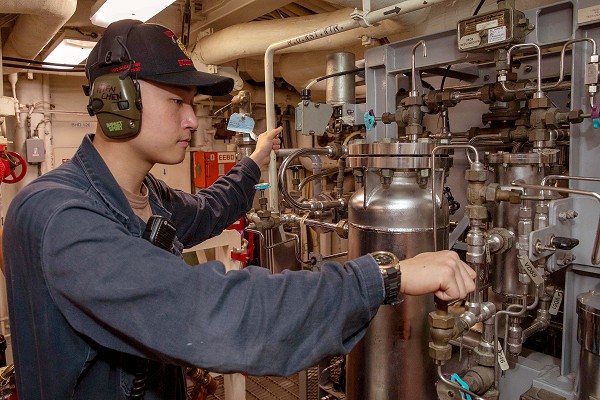
Atlantic Ocean, (March 30, 2023): There are few things more terrifying to a Sailor than being marooned at sea, surrounded by water, dying of thirst. In the above photo by MC2 Cryton Vandiesal, Hull Maintenance Technician Fireman Wenwei Chen aligns a reverse osmosis demineralizer aboard the Arleigh Burke-class guided missile destroyer USS Nitze. The Nitze is part of the George H.W. Bush Carrier Strike Group that is on a scheduled deployment to Naval Forces Europe with the U.S. 6th Fleet.
The challenge of maintaining an adequate water supply at sea had bedeviled mariners for centuries. In primitive times, a captain would carry as much water as possible because, once out of sight of land, their lives depended on it. Landlubbers will ask, “Why didn’t they just boil sea water to drink?” The answer is simple, boiling seawater does not remove salt, too much of which is deadly for humans. Fortunately, today’s mariners have the technology to convert enormous amounts of saltwater into drinking water through a process known as distillation. Distillation is accomplished by heating seawater to the boiling point to vaporize it. The vapors condense into a liquid which removes impurities and contaminants.
The next step in generating fresh water aboard a warship is through Osmosis, a process to desalinate ocean water by passing it through a thin, porous membrane that acts as both a filter and a salt barrier. Reverse Osmosis requires multiple stages of filtration to strip off additional minerals and other solid contaminants. In the final filtration stage, essential minerals are added back into the water to ensure Sailors receive the potable nutrition from that is healthy to drink.
So, how does the Navy provide fresh water to ships as large as an aircraft carrier?
- Details
- Hits: 2163
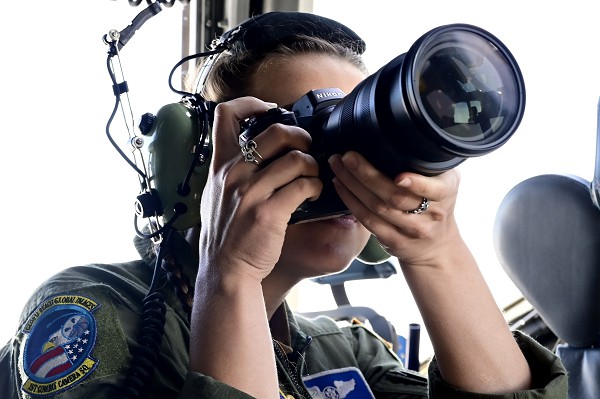
Charleston, North Carolina. (March 31, 2023): In this photo by Master Sergeant Matthew Plew, Airman 1st Class Natalie Vandergriff, an aerial combat camera journeyman, snaps actions photos during mobility force training missions over Charlotte, North Carolina. The 1st Combat Camera Squadron is the only active-duty combat camera unit in the Air Force that acquires imagery, both classified and not, for commanders and decision-makers in the field.
The Air Force Combat Camera Journeyman has played a courageous role recording military operations throughout the world. The images captured by these ordinary servicemembers have become some of the most iconic scenes of American at war. In addition to the deadly serious business of collecting classified information, the work of combat photographers helps shape both the image and public support for our nation’s military.
The story of the combat camera operators began during World War I when American Airmen flew some 35,000 hours capturing over 18,000 images of enemy positions. These primitive reconnaissance flights allowed American forces to “look over the horizon” to identify and target enemy formations, something that would prove vital to winning the war.
- Details
- Hits: 1631

Camp Pendleton, California. (March 8, 2023): In this photo by Corporal Trent Holton, a transmissions system operator with the 9th Communications Battalion, 1st Marine Expeditionary Force Information Group, uses a laser range finder-integrated capability system during ANGLICO Base Course (ABC). Marines undergo six weeks of intensive training, divided into three phases, to become combat ready “Anglicans.”
For today’s Marines, gone are the bulky backpack radios that weighed troops down in the jungles of Viet Nam. Today, Marine Transmissions System Operators maintain the military’s signature communications tool, the Very Small Aperture Terminal-Expeditionary vehicular or man pack radio set. The TSO fields and maintains these powerful, lightweight radio sets with their antennas and power sources. In combat, a TSO establishes contact with distant stations, processes and logs messages, and conducts frequency changes or cryptographic codes in real time. TSOs train to use highly specialized hardware/software programs to establish communications networks anywhere in the world.
The ABC Course expands these student’s grasp of transportation, communications, and call-for-fire missions. Students learn how to coordinate fire support, conduct field radio operations, and how to direct air support. They also receive training in airborne operations, insertion methods, fieldcraft, and other infantry skills.
- Details
- Hits: 2044
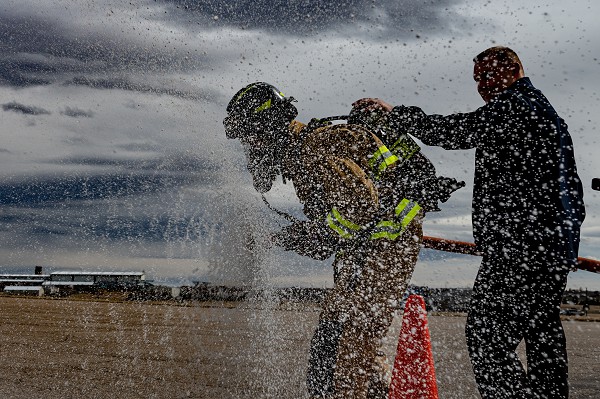
Buckley Space Force Base, Colorado. (March 21, 2023): In this photo by Senior Airman Danielle McBride, 2nd Lt. Keith M. Fetzner with the 460th Civil Engineer Squadron opens a valve on a fire hose and begins to spray water during a firefighter drill at Buckley Space Force Base. The drill gives realistic fire ground training under simulated stressful conditions to help soldiers understand the mental and physical exhaustion that comes with fighting fires and saving lives.
In wartime, the 460TH Civil Engineering Squadron does rapid repairs of airfields and other critical facilities where fire control is essential. The Air Force operates with unusual materials and in unique environments all over the world. Fire Protection Specialists must be prepared for anything, from brush fires to burning rocket fuel to hazardous material fires. These Air Force firefighters even back up local civilian fire departments in an emergency.
To become an Air Force firefighter, candidates must have a high school diploma plus 15 college credits, meet National Fire Protection Association physical standards, complete 7.5 weeks of Basic Military Training, and be between the ages of 17 and 39.In peacetime, the 460th’s job is to ensure the base is operating normally by maintaining infrastructure and conducting inspections. Base upkeep is a big responsibility for this squadron and requires dedication and teamwork making continuous repairs and upgrades on base.
- Details
- Hits: 1052
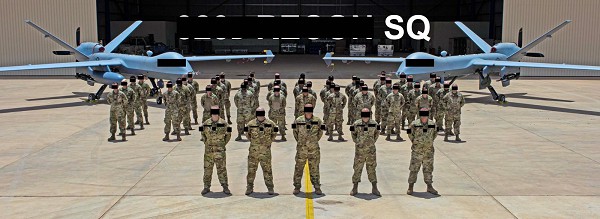
- The tempo of deployments and replacements is steadily increasing.
- Circumstances are growing in complexity.
- Events are increasing in frequency.
- Instability is increasing
National call for care goods for the troopsPlease pass this to all media outlets you know.The types of goods needed and the delivery address are listed here: https://supportourtroops.org/care-packagesShipments greater than (1) one pallet need to be approved in advance. Call 877-879-8882 or email
All Together Now!®
- Details
- Hits: 935
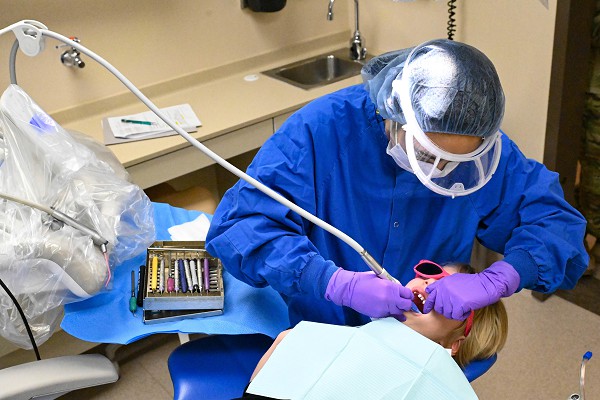
Ellsworth Air Force Base, South Dakota. (March 10, 2023): In this photo by Airman 1st Class Dylan Maher, Senior Airman Mikhaela Maglaque, a 28th Medical Group technician, cleans a child’s teeth during Childrens Dental Day, an annual clinic that provides free dental care for children of military servicemembers. The 28th provides outpatient medical care to 3,200 active-duty members and 17,000 beneficiaries, as well as retired personnel and their families.
The Ellsworth dental clinic provides the same high-level care as that of a civilian dental office, but the base clinic’s focus is to keep Airmen healthy and ready to fight U.S. adversaries. The clinic performs routine care such as fillings, endodontics (root canals), oral surgery such as wisdom teeth removal, crowns and bridges, and annual checkups.


